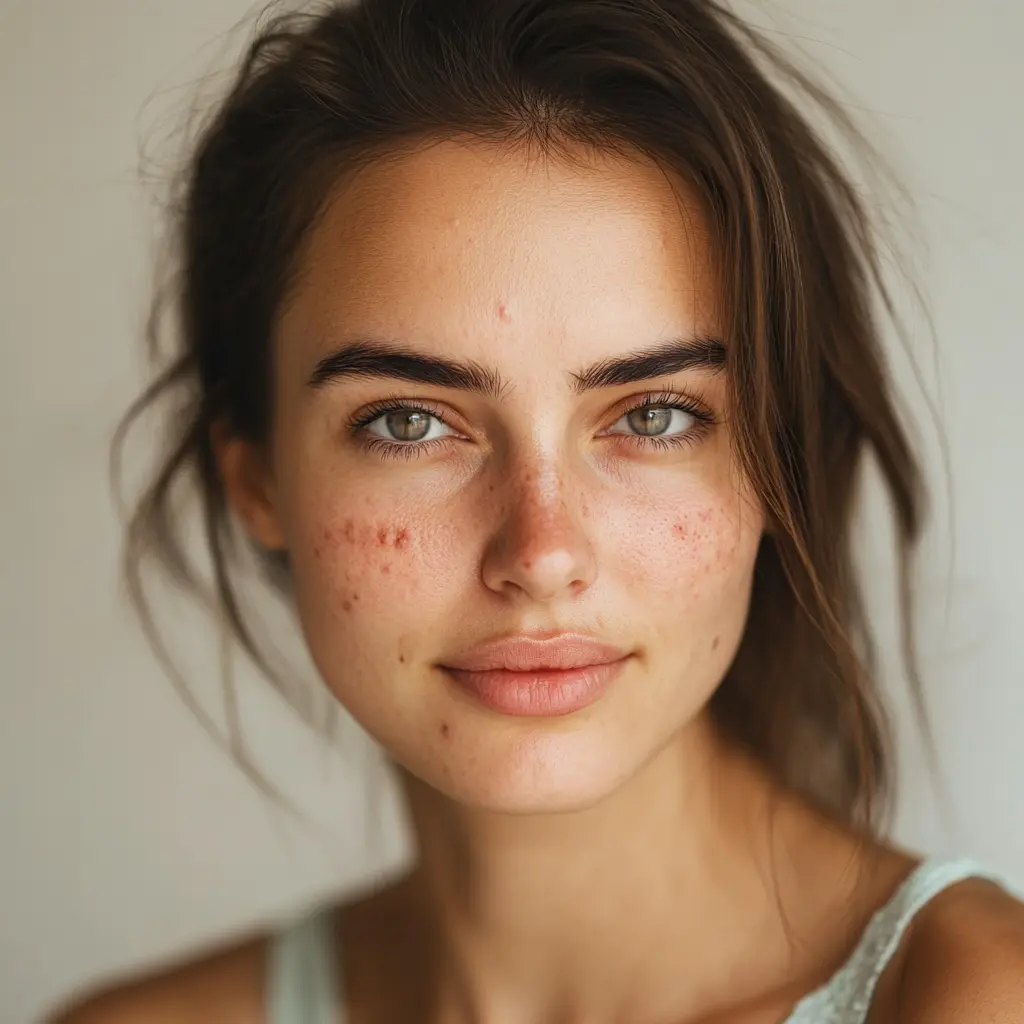Let’s face it—dealing with acne as an adult can feel like life’s cruel joke. Just when you think you’ve outgrown the breakouts and hormonal rollercoasters of your teenage years, those pesky pimples make an unwelcome comeback. And it’s not just you; adult acne is surprisingly common, affecting millions of men and women worldwide. It’s not just a teenage problem—it’s a skin condition that can persist well into your 30s, 40s, and beyond.
The causes? They’re as varied as the skincare aisles at your favorite store. From fluctuating hormones to stress overload, dietary choices, or even the wrong skincare routine, adult acne doesn’t play by one set of rules. And while it can be stubborn, the good news is that it’s also treatable with the right mix of science-backed tips, personalized skincare, and, sometimes, a little professional help.
This article is your ultimate guide to tackling adult acne head-on. Whether you’re dealing with an occasional breakout or full-on flare-ups, we’ll cover how to get rid of adult acne: tips and treatments that actually work. From simple everyday changes to professional-grade options, you’ll learn what causes adult acne, how to manage it effectively, and most importantly, how to get your confidence back.
If you’ve been Googling remedies and drowning in advice that feels more like a maze than a map, you’re in the right place. Here, we cut through the noise with expert-backed solutions tailored to adults—because, yes, your skin deserves more than just a trial-and-error approach. Ready to banish those breakouts and reclaim glowing skin? Let’s dive in.
Table of contents
Understanding Adult Acne
Before diving into treatments, let’s take a moment to understand what’s actually causing those unwelcome breakouts. Adult acne isn’t a one-size-fits-all issue, and it’s often triggered by a mix of internal and external factors. The more you know about what’s fueling your flare-ups, the easier it becomes to tackle them effectively.
Hormonal Fluctuations
Hormones are often the behind-the-scenes villain in adult acne. Fluctuations, particularly in androgens (like testosterone), can ramp up oil production. This excess oil, or sebum, mixes with dead skin cells, clogging pores and creating the perfect environment for acne-causing bacteria. This is why acne tends to worsen during certain times of the month for women, or during pregnancy, menopause, or conditions like PCOS.
Stress
life can be stressful, and your skin knows it. When you’re under pressure, your body pumps out more cortisol, a stress hormone that triggers inflammation and increases oil production. The result? Stress-induced acne, which seems to pop up exactly when you don’t need it.
Diet: You Are What You Eat
While the link between diet and acne isn’t fully settled, some evidence suggests that what you eat can play a role. High-glycemic foods—like sugary snacks, white bread, and junk food—can spike your blood sugar and lead to inflammation, worsening acne. Dairy, especially skim milk, has also been linked to breakouts, though the reason isn’t entirely clear.
Skincare Products: Friend or Foe?
Sometimes, the very products you rely on to help your skin might be causing more harm than good. Heavy creams, pore-clogging oils, or products with irritating ingredients can trigger breakouts. Even if your skincare routine worked for you in your 20s, your skin may have different needs now.
The Best Skincare Routine for Adult Acne
Building a skincare routine that actually works for adult acne is like crafting the perfect recipe—each ingredient (or step) has a purpose, and consistency is the secret sauce. Adult skin is different from teenage skin; it’s often drier, more sensitive, and needs a little extra care. Whether you’re a skincare newbie or someone looking to optimize your routine, here’s how to create a regimen that targets acne while keeping your skin healthy and balanced.
Morning Routine: Start Your Day Fresh and Protected
Your morning routine should focus on cleansing, treating, and protecting your skin to prep it for the day ahead.
Cleanser: Gentle but Effective
Start your day by washing your face with a gentle cleanser containing salicylic acid or benzoyl peroxide. These ingredients help clear out clogged pores and reduce inflammation without stripping your skin of its natural oils. Look for cleansers labeled as “non-comedogenic” to ensure they won’t block pores. If your skin is sensitive, consider alternating with a hydrating or soothing cleanser.
Pro Tip: Don’t over-cleanse! Washing your face twice in the morning won’t make acne disappear—it can actually irritate your skin and make things worse.
Treatment: Boost Your Glow
After cleansing, apply a vitamin C serum. This powerhouse ingredient brightens your skin, fades acne scars, and protects against environmental stressors like pollution. It’s a game-changer for keeping your skin tone even and radiant. Use 3-4 drops and pat it gently onto your skin, avoiding the eye area.
Why It Works: Vitamin C is an antioxidant that fights free radicals, which can worsen acne and aging.
Moisturizer: Hydrate Without the Grease
Even acne-prone skin needs hydration! Use an oil-free moisturizer that includes lightweight, hydrating ingredients like hyaluronic acid or glycerin. These ingredients lock in moisture without clogging your pores. If you’re battling redness or irritation, look for moisturizers with niacinamide, which calms inflammation.
Common Misconception: Skipping moisturizer because you think your skin is “too oily” can actually backfire. Dehydrated skin produces more oil, leading to more breakouts.
Sunscreen: Your Acne-Fighting Shield
This step is non-negotiable! Apply a broad-spectrum sunscreen with SPF 30 or higher to protect your skin from harmful UV rays. Sunscreen is especially important if you’re using acne treatments like retinoids or AHAs, which make your skin more sensitive to the sun. It also prevents acne scars from darkening and turning into stubborn hyperpigmentation.
Choose Wisely: Opt for sunscreens labeled as “non-comedogenic” and “oil-free.” Gel-based formulas are often a great choice for acne-prone skin.
Evening Routine: Clean, Treat, Repair
Your nighttime routine is all about removing the day’s dirt, treating acne, and allowing your skin to repair itself while you sleep.
Double Cleansing: Say Goodbye to Grime
If you wear makeup, sunscreen, or live in a polluted area, double cleansing is your secret weapon. Start with an oil-based cleanser to melt away makeup, sunscreen, and excess oil. Follow up with a water-based cleanser to remove any lingering residue. This two-step process ensures your skin is squeaky clean without being over-stripped.
Don’t Skip This! Double cleansing ensures treatments penetrate effectively, making them more powerful.
Treatment: The Star Ingredients
Evening is when your active ingredients do the heavy lifting. Incorporate a retinoid (like adapalene or tretinoin) or chemical exfoliants like AHAs/BHAs (glycolic or salicylic acid). These promote cell turnover, unclog pores, and reduce the appearance of fine lines. Apply a pea-sized amount all over your face, avoiding the eyes and lips.
Pro Tip: Start with retinoids every other night to allow your skin to adjust and minimize irritation.
Spot Treatments: Target Problem Areas
For those stubborn spots, use a targeted treatment with sulfur, benzoyl peroxide, or salicylic acid. Apply it directly to pimples to reduce swelling and redness overnight. Avoid overusing these treatments, as they can dry out your skin.
Night Cream: Repair While You Sleep
Finish your routine with a lightweight night cream to lock in moisture and support your skin’s repair process. Look for ingredients like ceramides to strengthen your skin barrier and centella asiatica for soothing properties. A strong skin barrier is essential for preventing irritation and reducing future breakouts.
Why Night Cream? At night, your skin goes into repair mode, making it the perfect time to replenish hydration and strengthen the barrier.
Professional Treatments for Stubborn Adult Acne
So, you’ve tried every cleanser, serum, and spot treatment on the shelves, but those pesky breakouts still won’t budge? Don’t worry—you’re not out of options. When over-the-counter products fall short, it might be time to bring in the pros. Dermatologist-recommended treatments are designed to tackle stubborn adult acne at the root, delivering real results through scientifically backed methods. Let’s break down some of the most effective professional options available today.
Chemical Peels
Chemical peels use exfoliating acids like salicylic or glycolic acid to deeply cleanse pores, remove dead skin cells, and fade acne scars. Customizable to your skin type, these peels can also improve texture and reduce hyperpigmentation. Expect a brighter, smoother complexion after a few sessions, though some peeling or redness is normal post-treatment.
Microneedling
Perfect for acne scars, microneedling creates tiny micro-injuries in the skin to stimulate collagen and elastin production. This minimally invasive treatment smooths scars, shrinks pores, and refines skin texture over time. Many dermatologists enhance it with serums or growth factors for even better results.
Blue Light Therapy
This gentle, non-invasive treatment uses specific wavelengths of light to kill acne-causing bacteria and reduce inflammation. Quick and painless, blue light therapy works especially well when paired with other acne-fighting strategies and requires no downtime.
Prescription Medications
For deep-rooted acne, prescription medications can be a game-changer:
- Isotretinoin: Known as Accutane, it’s a powerful solution for severe acne but requires careful monitoring due to potential side effects.
- Antibiotics: Topical or oral antibiotics can reduce bacteria and inflammation, especially for moderate to severe cases.
- Hormonal Treatments: Medications like oral contraceptives or spironolactone help regulate hormonal acne by controlling oil production.
A dermatologist will tailor these options to your skin’s needs for the best outcomes.
Lifestyle Changes for Clearer Skin
Healthy habits are as important as skincare when managing adult acne. Small adjustments can make a big difference for your skin.
Optimize Your Diet
- Eat Anti-Inflammatory Foods: Include leafy greens, omega-3-rich fish, and nuts.
- Limit Sugar and Dairy: These can trigger inflammation and acne in some people.
- Stay Hydrated: Water helps flush toxins and keeps skin hydrated.
Clean Your Environment
- Change Pillowcases Often: Swap them every 2–3 days to avoid bacteria buildup.
- Sanitize Your Phone: Clean it daily to prevent bacteria transfer to your face.
- Use Fresh Towels: Stick to clean, dedicated face towels.
Exercise and Sleep
- Reduce Stress: Relaxation techniques like yoga or meditation can prevent stress-related breakouts.
- Move Regularly: Exercise boosts circulation, helping your skin glow.
- Get Quality Sleep: Aim for 7–8 hours to regulate hormones and support skin repair.
Also Read: Essential Skincare Routine for Oily Skin: Products and Practices
Debunking Common Myths About Adult Acne
When it comes to adult acne, misinformation can do more harm than good. Let’s tackle some of the biggest myths so you can focus on effective solutions.
“Acne Is Just a Cosmetic Problem”
This myth downplays the complexity of acne. While it affects your appearance, acne is a medical condition tied to factors like hormones, inflammation, and bacteria.
The truth: Treating acne goes beyond improving your looks—it involves addressing underlying causes. Persistent or painful acne deserves professional attention.
“Scrubbing Harder Clears Acne”
Over-scrubbing may feel productive, but it actually irritates your skin, damages its barrier, and leads to more oil production—making acne worse.
The truth: Stick to gentle exfoliation with chemical exfoliants like salicylic acid, which unclog pores without causing irritation.
“Makeup Causes Acne”
Not all makeup is bad for your skin. Non-comedogenic, oil-free products are designed to prevent clogged pores.
The truth: Makeup doesn’t cause acne if properly removed. Use non-comedogenic products and double-cleanse at night to keep your skin clear.
“Adult Acne Is Caused by Poor Hygiene”
Acne isn’t a sign of being dirty. It’s often linked to internal factors like hormones and stress, not a lack of cleanliness.
The truth: Wash your face twice a day with a gentle cleanser, but avoid over-washing, which can irritate your skin.
“Acne Will Go Away on Its Own”
Waiting it out is rarely effective. Without proper care, acne can linger and leave scars.
The truth: Acne is treatable with targeted skincare, prescription treatments, or professional therapies. Taking action early prevents long-term damage.
Conclusion
Dealing with adult acne can feel overwhelming, but it’s important to remember that you’re not alone, and effective solutions are within reach. Whether your acne is caused by hormonal changes, stress, or lifestyle factors, there are proven ways to manage it—from a tailored skincare routine to professional treatments and simple lifestyle adjustments.
The key to success is understanding your skin, debunking the myths that might hold you back, and staying consistent with your approach. Patience is crucial—clear skin doesn’t happen overnight, but with the right care and mindset, you can achieve noticeable results and regain confidence in your skin.
At the end of the day, your journey to clearer skin is about progress, not perfection. Celebrate the small wins, don’t be afraid to seek expert help, and most importantly, treat your skin (and yourself) with kindness. You’ve got this!
Related Articles on BeautyStyleMag
- Natural Remedies for Acne That Really Work!
- 7 Best DIY Face Masks for Hydration, Brightening, and Acne
- Makeup for Acne-Prone Skin: Top Tips and Product Recommendations
For more inspiration, check out reliable resources like webmd.com and nhs.uk for expert advice.


